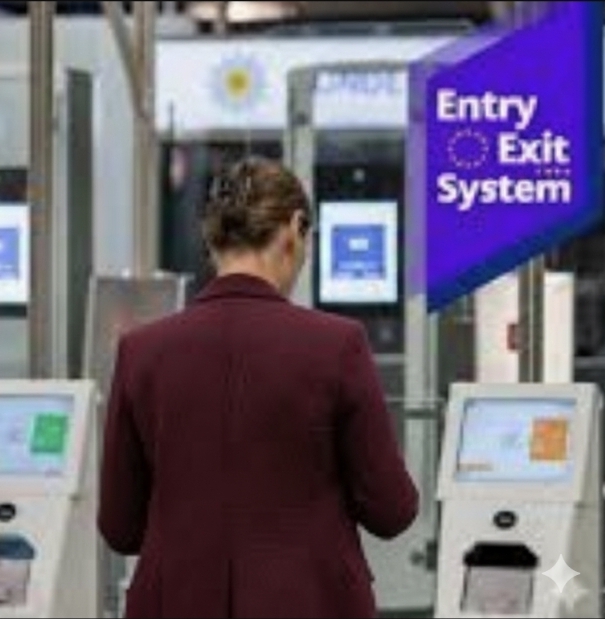
What is the Entry/Exit System (EES)?
- The EES is a digital border management system introduced by the European Union, beginning operations on 12 October 2025. (European Commission)
- It’s designed for travellers from outside the EU (non-EU nationals) who enter the Schengen Area for short stays (tourism, business, visits) — whether or not a visa is required. (Migration and Home Affairs)
- Key aim: to replace traditional passport stamping with an automated system that records entries and exits, improving security, reducing overstays, reducing identity fraud, and making border checks more efficient. (Consilium)
How Does EES Work in Practice?
Here are the main features and what travellers can expect:
| Aspect | What Happens |
|---|---|
| What data is collected | Passport/travel document information, a facial image/photo, fingerprint data, plus date and place of entry and exit. (Migration and Home Affairs) |
| When data is collected | On first entry by non-EU travellers after 12 October 2025. After that, subsequent entries or exits require faster verification rather than full registration each time. (European Commission) |
| Where implemented | At external border crossings of Schengen countries: airports, seaports, land borders. Implementation is gradual during a six-month transition period. (European Commission) |
| Transition period | From 12 October 2025 until 10 April 2026, border authorities will progressively roll out EES. During this period, some crossings may still do passport stamping; biometric registration may not be active at every crossing immediately. (European Commission) |
| Full operation | After the transition period, EES will be operational at all external Schengen border points; passport stamping will no longer be the norm. (European Commission) |
Who It Affects (and Who’s Exempt)
- Affected: Non-EU nationals (including UK citizens) travelling for short stays in Schengen Area. (European External Action Service)
- Exempt: Some travellers will be exempt under certain rules (for example, some long-stay visa or residence permit holders, possibly children in some cases). The specific exemptions are detailed on official EU / “Travel Europe / GOV.UK” resources. (GOV.UK)
What It Means for Travellers
- No more passport stamps (in most cases, after full implementation). Instead, entries and exits will be logged electronically via the EES. (European Commission)
- Biometric data collection will be required (fingerprint + photo) when you first use EES. Next time, a simpler verification. (European External Action Service)
- This system aims to make things more secure and accurate, especially for tracking overstays. But in the early months, travellers may face longer queues or delays at some crossings as procedures settle in and as infrastructure (kiosks, staff training) ramps up. (Financial Times)
- Travellers are encouraged to check ahead: see whether the border crossing you plan to use has implemented EES yet, what documents are needed, and what the process will look like. Official EU travel info webpages will provide up-to-date details. (European External Action Service)
Why the EES Was Introduced
- Improve border security and integrity across the Schengen external borders. (Consilium)
- Better monitoring of how long non-EU travellers stay in the Schengen Area, to catch those who overstay permitted periods. (Migration and Home Affairs)
- Reduce fraud and identity misuse. (Consilium)
- Make border crossings more efficient in the long-run. Though the rollout may cause some friction initially, the system promises faster, smoother process once fully adopted. (European External Action Service)
Key Dates to Know
- 12 October 2025 — the date EES begins operation. (European Commission)
- Six-month transition period afterward, allowing gradual rollout, partial implementation at certain border crossings, continued passport stamping during that time. (Consilium)
- 10 April 2026 — deadline by which EES should be fully operational at all external border crossing points. (European Commission)
What Travellers Should Do
- Check whether your travel document (passport) is valid and up to date; ensure it meets biometric standards if required.
- Be aware that at your first crossing under EES you’ll need to provide biometric info (fingerprint, facial image).
- Allow extra time for border crossings, especially during the early months. Some border crossings might be slower while the new system is being implemented.
- If you believe you are exempt (due to visa status, residency, or other rules), carry documentation to prove it.
- Keep an eye on official travel-advice sources (e.g. EU / GOV.UK / EU “Travel Europe”) for updates.
Conclusion
The Entry/Exit System marks a big step in how the EU manages border security and traveller flows. While not every border crossing point will look or feel different immediately, the shift from manual passport stamping to a biometric, electronic system promises faster, more secure, and more reliable movement across Schengen borders in the long term.
As with any large change, there will be bumps at first — delays, adjustment, confusion — but for travellers who stay informed and plan ahead, adapting should be manageable.

Leave a Reply